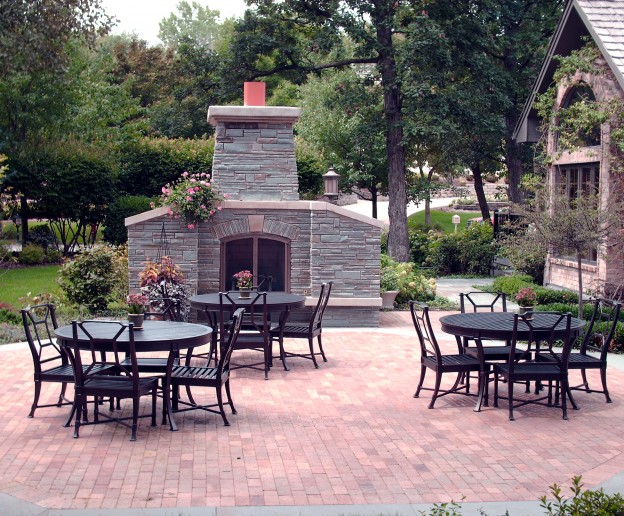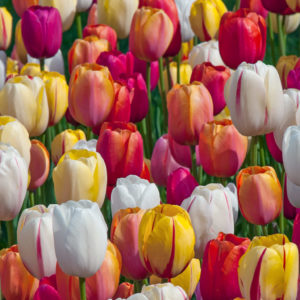
Tag Archives: landscape design


What’s the deal with Dirt
My guess is that many people don’t find dirt very interesting. But the truth is that people study it intensely. We actually employ someone who is a soils expert, Mike Curry!
So what exactly Is pulverized topsoil? Topsoil is the upper layer of the Earth’s crust, usually the top 2 to 8 inches. It has the highest concentration of microrganisms and organic matter and is where most of the soil’s biological activity occurs. Plants generally sink their roots into and obtain most of their nutrients from this rich layer.
This high concentration of organic matter is actually what turns soil black. So the darker it is, the more nutrients in the soil, the better your plants and turf will do. Ever notice “grey” colored dirt. It often occurs in areas where a lot of salt is applied during snow removal services. That’s because those microorganisms have been killed and the organic matter is leached out.
This is why it is so important to install mulch and compost in planting beds. It helps provide a protective layer and breaks down over time, reintroducing those beneficial nutrients back into that top layer of soil.
It’s also equally as important that you topdress your lawn with some kind of compost when core aerating and overseeding for the same reason.
Most people probably don’t know how topsoil is created. It’s a fairly simple process. Most often topsoil is taken from construction sites where there are large open spaces that need to be excavated anyway. That soil is then “pulverized” through a machine to remove any debris as well as giving it a more consistent texture that makes it easier to spread and fine grade.

Hire a Professional
You hear it all the time. If you are gong to hire someone for a project in your place of business or you home…hire someone who knows what they are doing. Think about it, if you received the news that you required surgery, would you hire someone who had not been to medical school? Probably not.
The perception of the landscape industry has always been an uphill battle. Consumers often don’t consider the importance of professional degrees and certifications as a necessity. I assure you, I have heard enough horror stories to know that hiring an individual or organization with the correct qualifications will save you money and peace of mind in the long run.
We get at least two phone calls a year inquiring if we can fix something that a consumer has already paid for. Perfectly good money wasted for all sorts of reasons…drainage issues were never considered. Water can be one of the most quickly damaging elements to your property. There is always the frustrated person complaining about a walkway or patio that after one winter are failing, most probably because the base layer was improperly considered and installed. Oh and that one year warranty they told you about…good luck getting them to return the call.
Maintenance is a huge issue. If pruning isn’t correctly done it can and mostly likely KILL your plants. When you invest in a new garden and don’t cultivate and weed properly, the weeds WILL win. And believe it or not, there is a correct and incorrect way to mow grass.
I could go on and on, however I won’t. What I will do is let this wonderfully created and produced video do the talking. ILT Vignocchi and Montale Gardens are proudly featured in a branding video for our industry. It shows my fellow contractor’s pride in what they do, a down right love for their crafts. CLICK HERE TO WATCH THE VIDEO. I know you will enjoy it.
Happy 50th Birthday ILT Vignocchi!!
Turning 50 is such a milestone for any business. Dips in the economy, increasing regulations, labor issues and shortages. There are so many ways a company can get off track. As I contemplate where we have been, of course I think of our unwavering reputation for integrity, artistry and quality. You consider the massive golf courses, Chicago Botanic Garden installations, as well as corporate and municipal work. I regard those residential projects that not only won awards but gave our employees such satisfaction and our customers heartfelt joy.
But to me it is more than that.
I don’t know if I have a memory when ILT didn’t exist. You see, as ILT turns 50, I will be turning 47. The memories of our company are like fabric woven into my life.
When I watch the countless trucks and trailers roll out of the yard at sunrise each and every morning I indulge the nostalgia of our company’s youth.
I remember Sorney Leahy who let me sit inside his desk drawer when I was very small and let me play with his phone. Or going to a job site with my dad on a Saturday. He’d hoist me up on his shoulders and then put me down so I could hug my Nono who was working with our men. A favorite is my mother who would spend hours picking up sticks before the maintenance crew came to our house so they would not have to bother.
50 years ago there were no computers. Dad used to spend countless nights drawing plans, scrunching up vellum with discarded ideas and yes, taking calls from his customers on his home phone.
I think life is different when you are in a family business. Of course it is hard and there are arguments, lots. But there is a short cut with family that makes it easier, because you know in the end, you will always love one another.
- Donna Vignocchi Zych
Benefits of Dormant Pruning
As landscape architects and arborists we often find that plant material on our new residential, commercial and HOA sites have been left to get overgrown and mismanaged. The key to getting the plant material looking healthy, vibrant and growing properly again is of course dormant pruning.
Dormant pruning takes place during the winter months and this is valuable for many reasons. With the leaves absent precision pruning is much easier. Cutting the plant in the right spot helps the plant heal better and faster in the growing season. It also allows us to see the shape of the plant better and see limbs and stems that are either damaged, diseased or crossing. The colder months also mean less airborne diseases that could affect the fresh wounds of plants.
A sure sign that dormant pruning needs to be done is the evidence of witches broom which is a dense mass of shoots growing from a single point. This happens when the plant is perpetually pruned or sheared on the top and never in the middle or base of the plant. This type of pruning leads to a plant that is top heavy with leaves, but looks bare and leggy on the stems and base.
Dormant pruning removes the witches broom, allows us to remove overgrown stems at the base of the plant and makes it easier to remove unwanted growth. These fixes allow sunlight and air to get to the entire plant and not only to the top sections. Heights of plants are also much more easily controlled during dormant pruning allowing the plant to take on a natural shape during the growing season without blocking windows or doors.
-Aaron Zych
Tulip Trivia
As I sit on this blisteringly cold January day my mind drifts to our lovely friend, the tulip.
You see my mother loves tulips. Even though we lived in Riverwoods and had to contend with deer feasting on them she would plant them. Not en masse but in charming little bundles that would cheerfully pop up in spring. She would sometimes even pair them with Allium, in order to deter our beautiful yet hungry friends.
Her love affair continues today, although now she must battle chipmunks and squirrels who enjoy digging them up and moving them around. This year I finally convinced her to even try my favorite tulip blend created by a most trusted vendor. It’s called French Blend. Wow, wait until she sees her spring display!
It’s difficult to think of spring on such a snow covered day, but it will come. My contemplating of the tulip has led me to some poking around. I’ve found some interesting tidbits that I thought I’d share…
- Origin Story: Thought that tulips originated in Holland? They did not. It is widely believed that they were first cultivated in a corridor along the 40° latitude between Northern China and Southern Europe.
- Tulips travel to Turkey: When the tulip first made its way to Turkey it was revered by the Sultan and was cultivated solely for his pleasure and that of his entourage. He forbid tulips to bought or sold outside of the capital. The punishment? Exile.
- A Status Symbol: Tulips were cultivated to be curated. They became a symbol of status and power for both Royalty and the very wealthy. Mirrors were placed around arrangements and in gardens to create the appearance that the owner could afford more than they actually could.
- A Bricklayer’s Wage for 15 years: At the height of what is called “Tulip Mania” once they had reached Holland, a single bulb would go for the price of a homepurchased in Amsterdam, or… a bricklayer’s wage for 15 years.
- There is an actual Tulip Museum…Outside: Keukenhof is worth the visit in May each year. I have been and I will never forget it. It is display garden after garden that is painstakingly designed and installed annually.
And that my friends, is just some of the fun facts around out delightful spring friend.
Donna Vignocchi Zych
Suburban Sanctuary NEW You tube video
On a sprawling 3 acres in Itasca, Illinois this property includes several relaxing vignettes, a putting green and tennis court. Perfect for entertaining it also boasts a custom fireplace and spa.
You have GOT to see this!
Don’t forget to follow us on You Tube to stay up to date on all of our exciting drone videos!
In case you were wondering: Has spring sprung?
|
|
OK, so May has finally arrived, and it looks like maybe Spring has finally sprung. But up until this week, it would have been hard to tell that spring was already here while walking around outside and observing the greenery, or lack of it.
Normally we would be seeing a lot more green this time of year in the way of leaf out on the deciduous trees and shrubs, but those buds are a little more reluctant to open in 2018. In case you were wondering when we can say Spring has actually started, read on…
Depending upon which definition you use, there are actually two different dates that the mark the scientific first day of spring.
1 March 2018 is the first day of the meteorological spring season
20 March 2018 is the first day of the astronomical spring season
Astronomical seasons refer to the position of Earth’s orbit in relation to the sun, taking into account equinoxes and solstices. Meteorological seasons are instead based on the annual temperature cycle and measure the meteorological state as well as coinciding with the calendar to determine a clear transition between the seasons.
Since the astronomical seasons vary in length, the start date of a new season can fall on different days each year. This makes it difficult to compare seasons between different years and resulted in the introduction of the meteorological calendar. This splits the calendar into four seasons of approximately the same length. The astronomical seasons run approximately three weeks later than those of the meteorological calendar.
All this scientific and statistical information aside, for most of us, and particularly those of us in the horticultural industries, the emergence of leaves on deciduous trees and the greening and growing of the grass signals the transition from winter to spring and the onset of the growing season. The flora that we are surrounded by does not know about our Gregorian calendar or the astronomical/meteorological movement of the planets. It is air temperature that is the most important factor in the “leaf out equation” regulating the budburst in woody plants; and the aspects of air temperature that most influence leaf-out timing can be broken down into two components: sufficient chilling in the winter, and warming temperatures in the spring that allow for the subsequent development of buds to the point of bursting. The term ‘chilling requirement’ refers to the exposure of plants to cold temperatures for a prescribed period of time before they will break dormancy. The specific amount of exposure to cold temperatures required to meet this chilling requirement differs among species but prolonged temperatures in the low fifties is the general threshold here in Chicago to initiate dormancy in late fall and to signal the plants to break dormancy in the early spring.
Temperatures here typically average around 51 degrees in the first half of April and 62 degrees for the last two weeks of the month, generally creating enough prolonged warmth to revive dormant plants and initiate the budburst. However, in 2018, we saw one of the coldest Aprils on record for the Chicago area; fourth coldest to be specific, with an average temperature through April 16th of 36.5 degrees; not conducive to helping plants break dormancy.
And for the record, that’s the coldest it’s been in Chicago to begin April since 1926, when the average temperature for April 1-15 was 36.4 degrees. The coldest first half of April on record was in 1881, when the average temperature for the first 15 days of the month was 33 degrees, according to the National Weather Service.
Warm temperatures are only part of the Spring equation that leads to the much-anticipated greening of our landscapes. Photoperiodism, the response of an organism to seasonal changes in day length, also plays a role in regulating the leaf-out of some woody plants. Not all species respond to photoperiod cues, and not all populations of a species have the same requirements. However, photoperiodism is directly associated with the movement of the planets, so it remains pretty consistent year to year in any given geographic region.
Rainfall is the other variable part of the “leaf-out equation”. If April showers are supposed to bring May flowers, we may have to wait a bit for those too. April was not particularly rainy this year. As a matter of fact, we actually had ten times more snow than rain this April; approx. 2″ of snow fell and only .02″ of rain, (compared to an average of approx. 2″ of rainfall).
So now you can put all of these fun cocktail party facts aside and don’t be alarmed if your trees and shrubs are not leafing out yet, or if your hostas, daylilies, and other perennials have not broken ground. The late hard frosts and light snow cover we saw in April may have spoiled the show for some of the very delicate early emerging flowering perennial plants, but for the most part, there will be no lasting damage as a result of the cold weather. Mother Nature has a way of protecting these plants by keeping them in dormancy until temperatures are tolerable for the newly exposed tender growth as buds open up. So be patient, and do not start pulling plants or planning replacements yet. Temperatures appear to have moderated and we are in store for a lot of sunshine in the short-term forecast so what you may have already written off as winter kill may surprise you and break bud in the next couple of weeks.
Kevin Block
VP
|
ILT Insider: Stink Bugs
Our Core Values: Quality Honesty Pride Teamwork Cleanliness Safety
|
|
I recently came across an article in The New Yorker titled “Home Invaders” about the history and increase of stinkbugs in homes. You know, those lazy, ugly bugs that look like little brownish gray shields. Since I am in the landscape industry I have a pretty good working knowledge of insects, skeptical this would enlighten me even more, I delved in.
Boy was I wrong, it was fascinating! If you are like me anyway and think bugs are fascinating…
The brown marmorated stinkbug (halyomorpha halys) was brought over from, most likely, East Asia, China, Taiwan, Japan or South Korea. The first sighting of the insect in the United States was on September 21, 1998 in Allentown, Pennsylvania. From that first discovery the insect population has grown in insurmountable numbers. This is not a good situation because the stinkbug does not have one food source it damages, like the emerald ash borer, but many. Sweet corn, soybeans, tomatoes, bell peppers, green beans, peaches, to name just a few. The article states “In orchards, they were crawling by the hundreds on every tree; so many had invaded corn and soybean fields that farmers had to turn on the windshield wipers in their combines while harvesting. Afterward, it wasn’t uncommon to find stinkbug damage on every single ear of corn.”
Insecticides do very little to rid these bugs due to their shape, the way they feed and the way their legs hold them above the top of a leaf (which prevents contact with the insecticide). Those characteristics that make insecticides non-effective in farm fields are what make spraying them in your home ineffective as well.
So, calling “The Orkin man” might prove costly and do nothing to rid your home of these pests. And a quick note, don’t squish or squash these guys as means of elimination, they got that name for a reason.
My question? “So why do so many show up in my house?” Well, that is the same reason there are thousands of them in farm fields. When the stinkbugs find food, or a place to overwinter in your attic, they release a pheromone that summons their friends. That pheromone can last for a year which can attract further generations into your home.
Is there good news? Yes, in summer the insects leave your home to reproduce and eat and in winter they enter, unfortunately in your home, a state called “diapause-a kind of insect hibernation.” This makes them extremely easy to catch in a cup and release back outside when they are hanging off your drapes or your walls.
The article is completely worth the read, if you have time on a Saturday morning while enjoying a cup of coffee. At least that is what I did.
Aaron Zych, RLA
Certified Arborist
|





